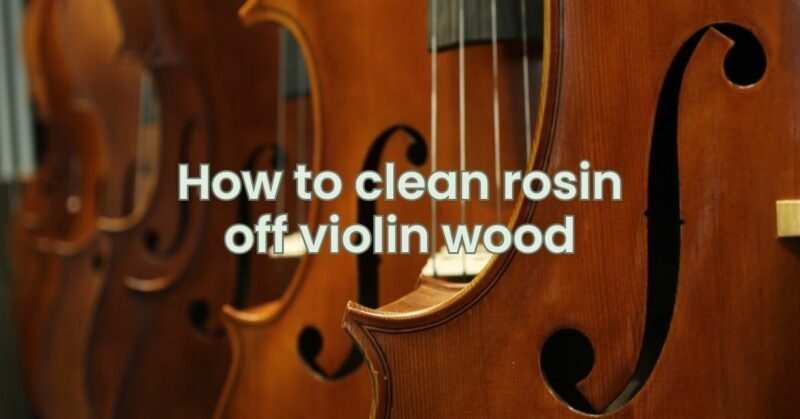Rosin is an essential accessory for violinists, as it provides the necessary friction between the bow and the strings, producing a clear and resonant sound. However, rosin can leave residue on the violin’s wood over time, affecting the instrument’s appearance and potentially impacting its sound quality. Properly cleaning rosin off the violin wood is essential for maintaining the instrument’s condition and preserving its tonal potential. In this step-by-step guide, we will explore effective methods to clean rosin off the violin wood safely and without causing any damage.
Step 1: Gather the Necessary Supplies
Before you begin cleaning the rosin off the violin wood, gather the necessary supplies:
- Soft, lint-free microfiber cloths
- A violin-specific cleaning solution (optional)
- Rubbing alcohol (70% isopropyl alcohol)
- Cotton swabs
- Violin polish (optional)
- Protective gloves (optional)
Step 2: Remove the Violin Strings
To clean the rosin effectively, it’s best to remove the violin strings temporarily. Loosen the tension of the strings by turning the corresponding fine tuners or pegs, and then gently lift each string off the violin’s tailpiece. Be careful during this process to avoid damaging the bridge or the soundpost.
Step 3: Dust Off the Residue
Use a soft, lint-free microfiber cloth to gently dust off any loose rosin residue from the violin’s wood surface. Be gentle to prevent scratching the varnish or damaging the wood. Use a separate cloth for each part of the violin, such as the top plate, back, sides, and scroll.
Step 4: Clean with Alcohol (For Stubborn Residue)
If there is stubborn rosin residue that does not come off with dry dusting, dampen a clean, soft cloth with rubbing alcohol (70% isopropyl alcohol). Gently rub the affected area with the alcohol-dampened cloth to remove the rosin residue. Make sure to avoid getting alcohol on any other parts of the violin, especially the varnish.
Step 5: Use Cotton Swabs for Hard-to-Reach Areas
For areas that are difficult to clean with a cloth, such as the scroll’s intricate carvings or the F-holes, use cotton swabs moistened with rubbing alcohol. Gently clean the hard-to-reach areas to ensure all rosin residue is removed.
Step 6: Apply a Cleaning Solution (Optional)
If the rosin residue is persistent or if you want to restore the violin’s luster, you may use a violin-specific cleaning solution. Apply a small amount of the solution to a clean, soft cloth and gently wipe the violin wood. Follow the manufacturer’s instructions carefully and avoid getting the solution on the varnish or any other sensitive parts of the instrument.
Step 7: Polish the Violin (Optional)
For an extra shine and protection, you may choose to apply a violin polish after cleaning. Use a clean, soft cloth to apply a thin layer of the polish, following the product’s instructions. Remember to use a polish that is suitable for the type of varnish on your violin.
Step 8: Reinstall the Violin Strings
After the cleaning process is complete, reattach the violin strings. Gradually tighten the strings using the fine tuners or pegs while making sure the bridge remains in its correct position.
Conclusion:
Cleaning rosin off the violin wood is an essential part of maintaining the instrument’s appearance and preserving its tonal potential. By following the step-by-step guide outlined in this article, you can safely and effectively remove rosin residue from the violin wood without causing any damage. Remember to use soft, lint-free cloths and avoid abrasive materials that may scratch the varnish. For stubborn residue, use rubbing alcohol, and be cautious when applying any cleaning solutions or violin polish. With proper care and maintenance, your violin will continue to produce its beautiful and resonant sound for years to come.


